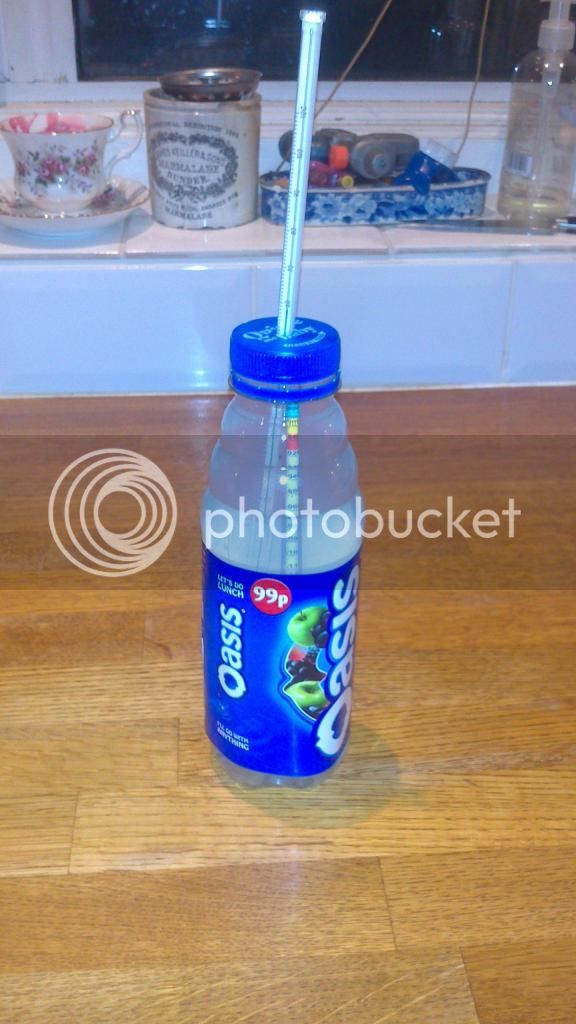Chaps,
I've just done my fourth brew. Previous brews have been - to put it mildly - not a roaring success. The first was undrinkable. The second suffered from a leaky keg and ended up down the drain. Number three is being drunk at the moment, but I don't get much pleasure from drinking it (it doesn't taste that good, to be brutally honest). Which brings me swiftly on to the fourth, now about an hour old!
I have to say, with such a dismal brewing history I can't help think I am doing something wrong. I assumed it was cleanliness, and for that reason bought some VWP for this brew (having used thin bleach before.) I put a large tablespoon in the FV with some boiling water, put the various bits of apparatus in with it and filled it up with cold water, right to the top, and left it to clean for two days. I then carefully syphoned the stuff out (into the keg, where it is now), rinsed everything at least three times under a cold water tap and kept all the apparatus on the upturned lid of the FV. I am sincerely hoping that this is enough; I can't think there is anything else I could do but didn't in order to keep everything clean.
Having said that I did (stupidly) forget to soak the tin opener in VWP before using it. It was clean but hadn't been sterilised. How important is this? (I guess that's the subsiduary question; how clean do things have to be? Surgically sterile? I'm guessing not as this is impossible. I handled everything with my own hands without gloves, which I assume is what everyone else does. Is this a problem? If it is, what can be done about it?
Another question I have is about the gravity; when I measured the gravity of the wort before putting the yeast in, I got a reading of 1.015. This seems quite low - is it right? I struggled to read the gauge on the side of the hydrometer as there was a lot of froth around, but I don't think I am that far out.
Another question is about the cleanliness of the hydrometer (and thermometer) when testing the brew in the FV. I can see that a number of people use a testing jar, which I don't have one of, so I will be floating the hydrometer in the brew to test the gravity. This clearly requires a clean hydrometer, and I'm keeping it in an old plastic bottle with some VWP solution and the thermometer, like this:

Is this likely to work, or is this a bad idea? Has anyone else done this and able to offer comment?
Thanks for your input and suggestions. I'm kinda hoping that this one will work, and produce some beer which I actually want to drink; the elusive grail which has eluded me to date ...
Oli.
I've just done my fourth brew. Previous brews have been - to put it mildly - not a roaring success. The first was undrinkable. The second suffered from a leaky keg and ended up down the drain. Number three is being drunk at the moment, but I don't get much pleasure from drinking it (it doesn't taste that good, to be brutally honest). Which brings me swiftly on to the fourth, now about an hour old!
I have to say, with such a dismal brewing history I can't help think I am doing something wrong. I assumed it was cleanliness, and for that reason bought some VWP for this brew (having used thin bleach before.) I put a large tablespoon in the FV with some boiling water, put the various bits of apparatus in with it and filled it up with cold water, right to the top, and left it to clean for two days. I then carefully syphoned the stuff out (into the keg, where it is now), rinsed everything at least three times under a cold water tap and kept all the apparatus on the upturned lid of the FV. I am sincerely hoping that this is enough; I can't think there is anything else I could do but didn't in order to keep everything clean.
Having said that I did (stupidly) forget to soak the tin opener in VWP before using it. It was clean but hadn't been sterilised. How important is this? (I guess that's the subsiduary question; how clean do things have to be? Surgically sterile? I'm guessing not as this is impossible. I handled everything with my own hands without gloves, which I assume is what everyone else does. Is this a problem? If it is, what can be done about it?
Another question I have is about the gravity; when I measured the gravity of the wort before putting the yeast in, I got a reading of 1.015. This seems quite low - is it right? I struggled to read the gauge on the side of the hydrometer as there was a lot of froth around, but I don't think I am that far out.
Another question is about the cleanliness of the hydrometer (and thermometer) when testing the brew in the FV. I can see that a number of people use a testing jar, which I don't have one of, so I will be floating the hydrometer in the brew to test the gravity. This clearly requires a clean hydrometer, and I'm keeping it in an old plastic bottle with some VWP solution and the thermometer, like this:

Is this likely to work, or is this a bad idea? Has anyone else done this and able to offer comment?
Thanks for your input and suggestions. I'm kinda hoping that this one will work, and produce some beer which I actually want to drink; the elusive grail which has eluded me to date ...
Oli.



